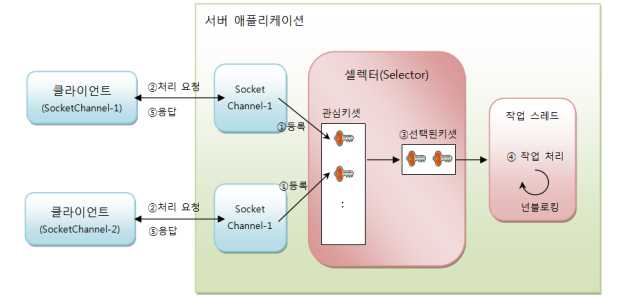Non-blocking I/O
https://en.wikipedia.org/wiki/Non-blockingI/O(Java)
The APIs of NIO were designed to provide access to the low-level I/O operations of modern OS
NIO
https://docs.oracle.com/javase/10/docs/api/java/nio/package-summary.html
- New Input Output API package
- java.nio : buffer class
- java.nio.channels : file channel, tcp channel, udp channel
- channel (양방향) ↔ stream (단방향-기존 IO)
- 동기, 비동기 모두 지원
- 블로킹, 넌블로킹 모두 지원
Non Blocking operation
- connect(), accept(), read(), write() 즉시 리턴됨으로 작업 준비가 된 채널만 선택해서 처리해야함
-
Selector 필요 → Channel 작업 처리가 준비된 채널 선택
- Selector : event listener
- channel 작업 처리 준비 → selector 에 통보
- selector → 통보받은 channel 선택
- 작업 스레드가 블로킹되지 않기 때문에 selector가 선택한 채널을 메소드 호출 후 리턴한 하나의 스레드에서 다시 처리함
- 스레드풀을 사용하는 경우, 적은 수의 스레드로 많은 양의 작업 처리
Selector operation
-
채널은 자신의 작업 유형을 키(Selection Key)로 생성
selector.register() → selectionKey 생성한 후 관심키셋에 저장
- register the selection key to selector’s interest-set
- selector detects key’s ready channel in interest-set, update it to selected-key set
-
working threads operate the key in selected-key set (작업 스레드가 채널 작업을 처리할 때 SelectionKey필요)
→ with SelectionKey, 작업유형 변경, 첨부 객체 저장, 채널 등록 취소
SelectionKey
- selector.register() 로 생성됨
- 작업 유형 정보를 가짐(읽기, 쓰기,)
- 작업 스레드가 채널작업을 할 때 필요로함
- 채널의 keyFor() 메소드로 얻을 수 있음
Selector creation
try {
Selector selector = Selector.open();
} catch (IOException e)Selector registration
// 어떤 작업에 관심을 둘지 ops
SelectionKey selectionKey = serverSocketChannel.register(Selectot sel, int ops);
SelectionKey selectionKey = socketChannel.register(Selector sel, int ops);IO Stream Blocking
- input stream → read() → block thread before the data input
- output stream → write() → block thread before the data out
- no interrupt allowed
- large and sequential data
Selectors
- provides a mechanism for waiting on channels and recognizing when one or more become available for data transfer.
- When a number of channels are registered with the selector, it enables blocking of the program flow until at least one channel is ready for use, or until an interruption condition occurs. → select() returns
- selector.wakeup(): 작업유형을 변경하고(selectionKey) selector 에 알려주기 위해 사용
- Although this multiplexing behavior could be implemented with threads, the selector can provide a significantly more efficient implementation using lower-level operating system constructs.
- multiplexor of SelectableChannel objects
- created by invoking open method(use the system’s default selector provider to create a new selector)
- remains open until close method
-
three sets of selection keys
-
key set : the current registrations of this selector returned by key method
added to a selectors’ key set as a side effect of registering a channel via the channel’s register method
-
selected-key set : each key’s channel was detected to be ready for at least one of the operations identified in the key’s interest set during a prior selection operation that adds keys or updates keys in the set returned by selectedKeys method
removed by invoking the remove method
-
cancelled-key : the set of keys that have been cancelled but whose channels have not yet been deregistered.
added to selector’s cancelled-key set when it is canceled by closing its channel or invoking its cancel method
-
Channel Operation in working threads
- selected-key set 에서 selectionKey를 하나씩 꺼내 작업 유형 확인
-
작업 유형별(the selectionKey)로 채널 객체 얻기
ServerSocketChannel serverSocketChannel = (ServerSocketChannel) selectionKey.channel();selectionKey 의 첨부객체를 얻기도 함
